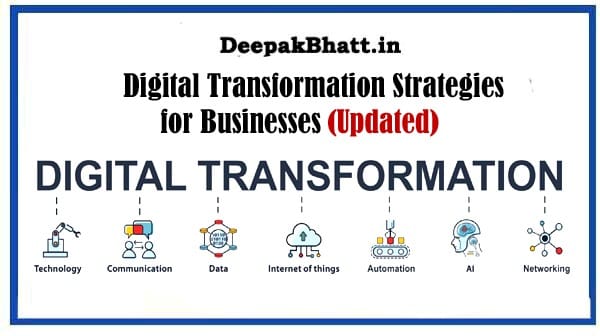Digital Transformation In the ever-evolving landscape of technology, businesses that embrace digital transformation
Gain a competitive edge, ensuring agility, innovation, and sustained growth. As we navigate through 2024, the importance of digital transformation has never been more pronounced.
Local SEO Course: A Definitive Guide 87% Free
Marketing Analytics: Pricing Strategies And Price Analytics
Internet of Things (IoT): Connecting the World around
Cybersecurity in a Digital Age: Protecting Your Online Presence
- 1 Digital Transformation Strategies
- 1.1 1. Cloud-Native Architecture
- 1.2 2. Artificial Intelligence (AI) and Machine Learning (ML) Integration
- 1.3 3. Data-Driven Decision-Making
- 1.4 4. Cybersecurity Resilience
- 1.5 5. Customer-Centric Digital Experiences
- 1.6 6. Internet of Things (IoT) Integration
- 1.7 7. Collaboration Tools and Remote Work Infrastructure
- 1.8 8. Blockchain Technology for Transparency and Security
- 1.9 9. Continuous Learning and Adaptability
- 1.10 10. Ethical and Sustainable Digital Practices
- 1.11 Conclusion: Paving the Way for Future Success
Digital Transformation Strategies
This article explores cutting-edge digital transformation strategies that businesses can adopt to stay ahead in the dynamic and tech-driven business environment.
1. Cloud-Native Architecture
Why it Matters: Embracing a cloud-native approach enables businesses to leverage the full potential of cloud computing, fostering scalability, flexibility, and cost efficiency. Cloud-native architectures allow for seamless integration with emerging technologies and provide a foundation for rapid innovation.
Key Actions:
- Migrate critical systems and applications to cloud platforms.
- Adopt containerization and microservices architecture for enhanced scalability and agility.
- Invest in cloud-native development tools and practices.
2. Artificial Intelligence (AI) and Machine Learning (ML) Integration
Why it Matters: AI and ML have become integral to business operations, offering advanced analytics, automation, and predictive capabilities. Implementing these technologies enhances decision-making processes, customer experiences, and operational efficiency.
Key Actions:
- Integrate AI-driven analytics for data-driven decision-making.
- Implement ML algorithms for predictive analytics and process automation.
- Explore AI-powered chatbots and virtual assistants to enhance customer interactions.
3. Data-Driven Decision-Making
Why it Matters: Data is the lifeblood of digital transformation. Harnessing the power of data through advanced analytics enables businesses to make informed decisions, optimize processes, and identify new opportunities for growth.
Key Actions:
- Establish a robust data governance framework.
- Invest in advanced analytics tools for real-time insights.
- Foster a data-driven culture across the organization.
4. Cybersecurity Resilience
Why it Matters: As businesses become increasingly digital, cybersecurity is paramount. A robust cybersecurity strategy safeguards sensitive data, protects against cyber threats, and ensures the integrity of digital operations.
Key Actions:
- Conduct regular cybersecurity audits and assessments.
- Implement multi-layered security protocols and encryption.
- Provide ongoing cybersecurity training for employees.
5. Customer-Centric Digital Experiences
Why it Matters: Customer expectations are evolving, and businesses must prioritize delivering seamless digital experiences. A customer-centric approach ensures satisfaction, loyalty, and positive brand perception.
Key Actions:
- Develop user-friendly and responsive digital interfaces.
- Implement personalization strategies based on customer data.
- Utilize customer feedback to continuously enhance digital experiences.
6. Internet of Things (IoT) Integration
Why it Matters: IoT devices are proliferating, offering businesses the ability to gather real-time data, enhance operational efficiency, and create new revenue streams. Integrating IoT into digital strategies opens avenues for innovation.
Key Actions:
- Identify areas for IoT implementation in business processes.
- Invest in IoT-enabled devices and sensors.
- Implement analytics to derive insights from IoT-generated data.
7. Collaboration Tools and Remote Work Infrastructure
Why it Matters: The rise of remote work necessitates robust collaboration tools and infrastructure. Digital transformation includes creating an environment that facilitates seamless communication and collaboration, regardless of geographical locations.
Key Actions:
- Adopt collaborative platforms for remote work.
- Ensure secure access to company resources from various locations.
- Foster a culture that supports remote collaboration and flexibility.
8. Blockchain Technology for Transparency and Security
Why it Matters: Blockchain technology is not limited to cryptocurrencies; it offers enhanced transparency and security across various industries. Implementing blockchain can streamline processes, reduce fraud, and improve trust in business transactions.
Key Actions:
- Explore use cases for blockchain in supply chain, finance, or contract management.
- Collaborate with industry partners on blockchain initiatives.
- Stay informed about evolving blockchain applications.
9. Continuous Learning and Adaptability
Why it Matters: The digital landscape is ever-changing, and businesses must cultivate a culture of continuous learning and adaptability. This involves staying abreast of emerging technologies, industry trends, and evolving customer expectations.
Key Actions:
- Invest in employee training programs for digital skills.
- Encourage cross-functional collaboration and knowledge-sharing.
- Foster a mindset that embraces change and innovation.
10. Ethical and Sustainable Digital Practices
Why it Matters: As businesses digitize, ethical considerations become crucial. Embracing sustainable and ethical digital practices not only aligns with societal expectations but also safeguards brand reputation in an era where corporate responsibility is under scrutiny.
Key Actions:
- Develop and communicate clear ethical guidelines for digital practices.
- Integrate sustainability into technology decision-making processes.
- Engage in initiatives that contribute to social and environmental well-being.
Conclusion: Paving the Way for Future Success
Digital transformation is not a one-time event but a continuous journey towards innovation and resilience. By embracing these cutting-edge strategies, businesses can navigate the complexities of 2024 and position themselves as leaders in their respective industries.
आप सभी का मेरी वेबसाइट पर स्वागत है। मैं Blogging, earning money online और अन्य Categories से संबंधित Post Updates करता रहता हूँ। यहाँ आपको बहुत अच्छी Post पढ़ने को मिलेंगी। जहाँ से आप बहुत सारा Knowladge बढ़ा सकते हैं। आप हमारी website और Social Media के माध्यम से हमसे जुड़ सकते हैं। धन्यवाद







